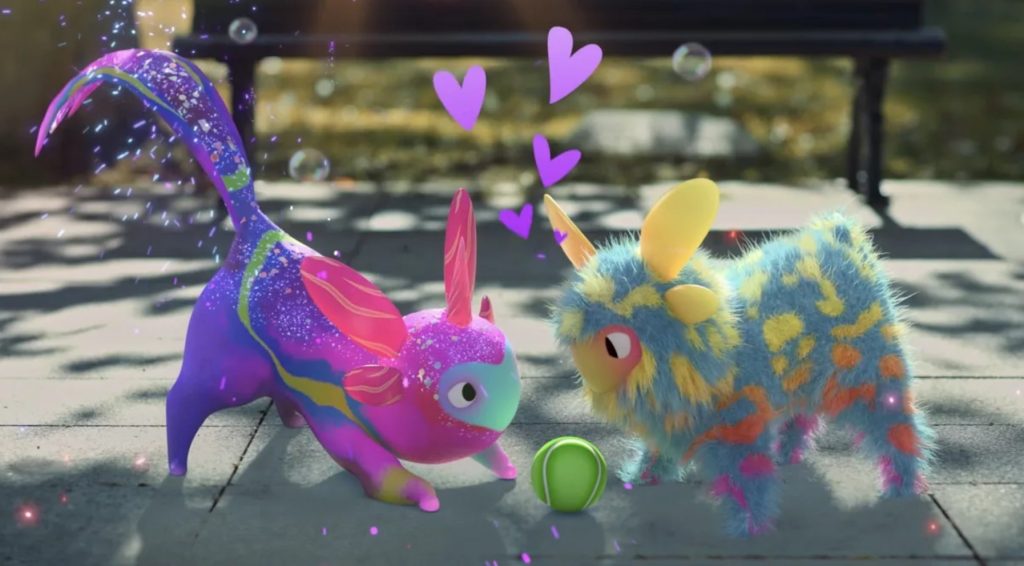
Despite massive hits like Niantic’s own Pokemon Go, augmented reality games on mobile have yet to live up to their promise. Huge investments like Minecraft Earth failed to catch fire. Pokemon Go came out way back in 2016 and even Niantic’s 2021 release Pikmin Bloom was, at best, a qualified success.
Peridot, out today, is the latest attempt to replicate Pokemon Go’s success and cultural impact. I downloaded the pet simulation earlier today, and got to know my first little friend (Little Pinny) petting and feeding her, while going out for walks to play and forage. So far, I love the game, and I’m encouraged by the generally positive reception from reviewers who’ve had longer to explore its mysteries.
So what is Peridot all about? Many media reviews today, like The Guardian’s, are calling it “Tamagotchi for the next generation,” which sums the game up at its most basic level. The AR element though, is far more interesting than the gameplay loop of paying attention to a pet and watching it thrive and grow.
Although AR is nothing new, the tech still has a long way to go. Peridot isn’t perfect about placing Little Pinny in the world, but the game still manages to deliver a little thrill for me watching her hanging around on my kitchen floor beside my cats. Disappointingly, the cats were oblivious to their new baby sister! But I’m told that dots will recognize household pets, though that hasn’t happened yet for me.
The main AR interface involves drawing circles on the ground, and watching as your dot dives underground for a second or two, before re-emerging with some prize, often food or treats, as well as toys and gizmos. Different surfaces yield different kinds of prizes, so players are motivated to go out and explore. For example, one of my tasks is to lead Little Pinny to some sand so she can get a beach ball. Peridot is, of course, a map-based game, and so there are also points of likely interest where special items might be found.
The game has a strong social element. It also comes with advanced camera and image editing functionality that allows for sharing on social apps.
Environmental angle
Interestingly, Peridot has a quasi-environmental story behind its activities. The Peridots (“dots” for short) have been sleeping for a very long time, but now they need to be reintegrated into the world. It’s the player’s job to help the dots repopulate. So, not only am I tasked with keeping Little Pinny happy, but raising her to adulthood, and helping her mate and reproduce.
This reproduction mechanic, in which the supposedly unique DNA combinations of each dot are thrown into the evolutionary pot, is designed to sustain interest beyond the initial “awww, cute” response. It requires interacting with other players, and arranging dates between dots, that end up yielding offspring.
As The Verge’s review points out today: “In Pokémon Go, you try to catch ‘em all; in Peridot, you try to collect all of the characteristics by continuously breeding your dots to hatch new ones so you can have pets with a tropical fish pattern or a skeleton tail. As hooks go, it’s not quite as catchy. But the more you play, the more characteristics and archetypes you’ll unlock.”
So what is Niantic trying to achieve with this game? Eurogamer has some interesting quotes today from the game’s creative lead Ziah Fogel, which suggest how much the company is looking ahead to emerging technologies and metaverse-like experiences.
“For me, AR is this new forefront,” says Fogel. “A really interesting opportunity for Niantic that I’m excited about is defining a new user interface for how people are going to interact with this technology. In the future, when we’re all using headsets… how are people going to interact with that? Some of the decisions we’re making over how people interact even through their phone are potentially going to be influential.”
Meanwhile, Niantic has cut a deal with Amazon to include virtual shopping areas in the AR world. The retail giant’s “Amazon Anywhere” initiative was announced today, in which “you can now discover and buy physical products from Amazon stores without ever having to leave your game or app,” according to the company. Peridot is its first outing.
This is a curious monetization effort, in which players are encouraged to buy merch while they’re still in the game (they’ll need to link their Amazon account). But Peridot’s core monetization is old-fashioned gatekeeping. Players are limited in how many dots they can breed, and those who want to amass large collections are asked to pay for “Nests” that will allow them broader collections.
This element has not gone down quite as well with reviewers who, having played the game for a week or so, seem to find it too restrictive. TheGamer’s review points out: “There’s a convoluted system of overlapping currencies that all feed into the breeding process … There’s no way to earn Nests or find them by foraging. You either pay up, or you can’t participate in breeding.”
Undoubtedly though, Niantic sees Peridot as a big bet. As Fogel posted on LinkedIn: “I think it’s safe to say that Peridot is one of the most innovative and groundbreaking products out there – it’s completely unique to anything currently on the market.”
Colin Campbell has been reporting on the gaming industry for more than three decades, including for Polygon, IGN, The Guardian, Next Generation, and The Economist.
 GameDaily.biz © 2025 | All Rights Reserved.
GameDaily.biz © 2025 | All Rights Reserved.